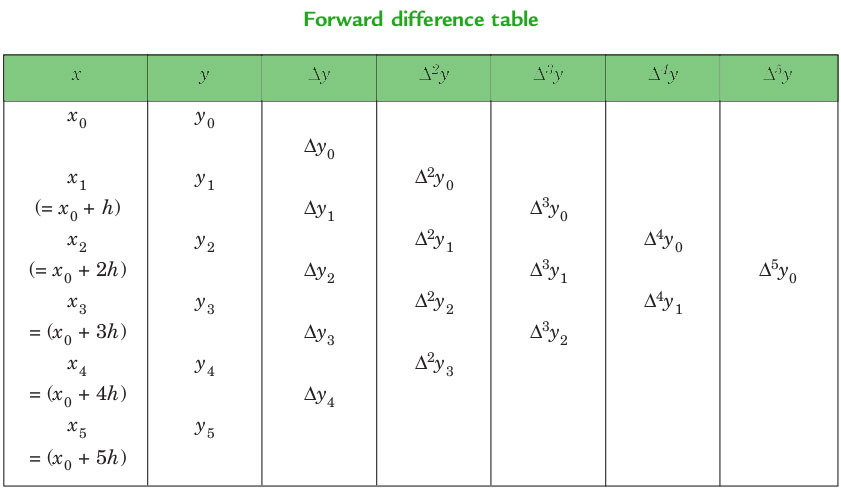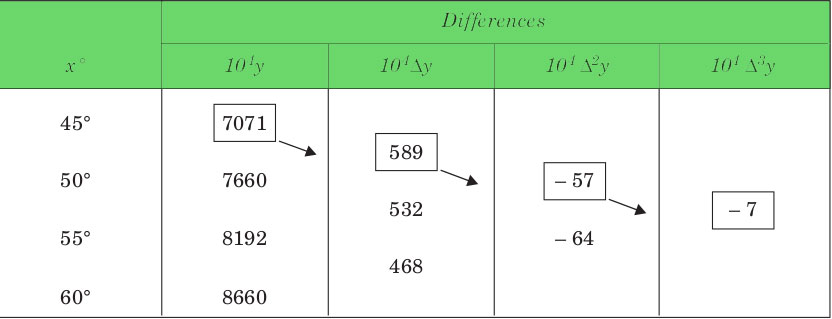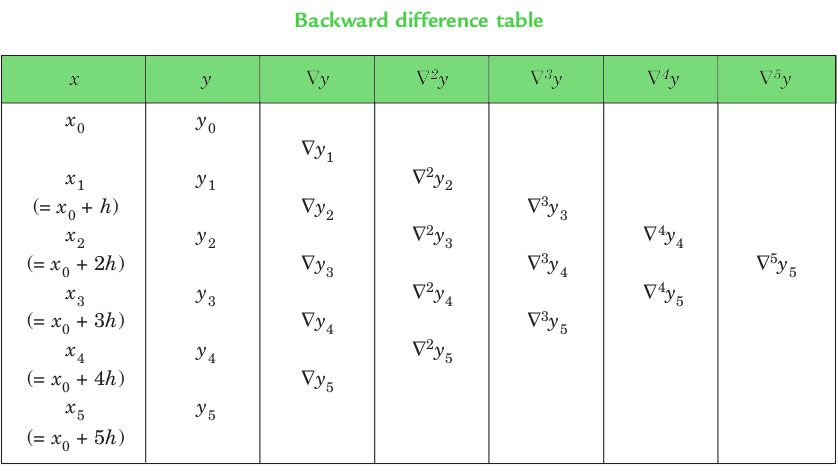Newton Forward And Backward Interpolation
Last Updated :
10 Mar, 2023
Interpolation is the technique of estimating the value of a function for any intermediate value of the independent variable, while the process of computing the value of the function outside the given range is called extrapolation.
Forward Differences: The differences y1 – y0, y2 – y1, y3 – y2, ……, yn – yn–1 when denoted by dy0, dy1, dy2, ……, dyn–1 are respectively, called the first forward differences. Thus, the first forward differences are :


NEWTON’S GREGORY FORWARD INTERPOLATION FORMULA :

This formula is particularly useful for interpolating the values of f(x) near the beginning of the set of values given. h is called the interval of difference and u = ( x – a ) / h, Here a is the first term.
Example :
Input : Value of Sin 52

Output :

Value at Sin 52 is 0.788003
Below is the implementation of the Newton forward interpolation method.
C++
#include <bits/stdc++.h>
using namespace std;
float u_cal(float u, int n)
{
float temp = u;
for (int i = 1; i < n; i++)
temp = temp * (u - i);
return temp;
}
int fact(int n)
{
int f = 1;
for (int i = 2; i <= n; i++)
f *= i;
return f;
}
int main()
{
int n = 4;
float x[] = { 45, 50, 55, 60 };
float y[n][n];
y[0][0] = 0.7071;
y[1][0] = 0.7660;
y[2][0] = 0.8192;
y[3][0] = 0.8660;
for (int i = 1; i < n; i++) {
for (int j = 0; j < n - i; j++)
y[j][i] = y[j + 1][i - 1] - y[j][i - 1];
}
for (int i = 0; i < n; i++) {
cout << setw(4) << x[i]
<< "\t";
for (int j = 0; j < n - i; j++)
cout << setw(4) << y[i][j]
<< "\t";
cout << endl;
}
float value = 52;
float sum = y[0][0];
float u = (value - x[0]) / (x[1] - x[0]);
for (int i = 1; i < n; i++) {
sum = sum + (u_cal(u, i) * y[0][i]) /
fact(i);
}
cout << "\n Value at " << value << " is "
<< sum << endl;
return 0;
}
|
Java
class GFG{
static double u_cal(double u, int n)
{
double temp = u;
for (int i = 1; i < n; i++)
temp = temp * (u - i);
return temp;
}
static int fact(int n)
{
int f = 1;
for (int i = 2; i <= n; i++)
f *= i;
return f;
}
public static void main(String[] args)
{
int n = 4;
double x[] = { 45, 50, 55, 60 };
double y[][]=new double[n][n];
y[0][0] = 0.7071;
y[1][0] = 0.7660;
y[2][0] = 0.8192;
y[3][0] = 0.8660;
for (int i = 1; i < n; i++) {
for (int j = 0; j < n - i; j++)
y[j][i] = y[j + 1][i - 1] - y[j][i - 1];
}
for (int i = 0; i < n; i++) {
System.out.print(x[i]+"\t");
for (int j = 0; j < n - i; j++)
System.out.print(y[i][j]+"\t");
System.out.println();
}
double value = 52;
double sum = y[0][0];
double u = (value - x[0]) / (x[1] - x[0]);
for (int i = 1; i < n; i++) {
sum = sum + (u_cal(u, i) * y[0][i]) /
fact(i);
}
System.out.println("\n Value at "+value+" is "+String.format("%.6g%n",sum));
}
}
|
Python3
def u_cal(u, n):
temp = u;
for i in range(1, n):
temp = temp * (u - i);
return temp;
def fact(n):
f = 1;
for i in range(2, n + 1):
f *= i;
return f;
n = 4;
x = [ 45, 50, 55, 60 ];
y = [[0 for i in range(n)]
for j in range(n)];
y[0][0] = 0.7071;
y[1][0] = 0.7660;
y[2][0] = 0.8192;
y[3][0] = 0.8660;
for i in range(1, n):
for j in range(n - i):
y[j][i] = y[j + 1][i - 1] - y[j][i - 1];
for i in range(n):
print(x[i], end = "\t");
for j in range(n - i):
print(y[i][j], end = "\t");
print("");
value = 52;
sum = y[0][0];
u = (value - x[0]) / (x[1] - x[0]);
for i in range(1,n):
sum = sum + (u_cal(u, i) * y[0][i]) / fact(i);
print("\nValue at", value,
"is", round(sum, 6));
|
C#
using System;
class GFG
{
static double u_cal(double u, int n)
{
double temp = u;
for (int i = 1; i < n; i++)
temp = temp * (u - i);
return temp;
}
static int fact(int n)
{
int f = 1;
for (int i = 2; i <= n; i++)
f *= i;
return f;
}
public static void Main()
{
int n = 4;
double[] x = { 45, 50, 55, 60 };
double[,] y=new double[n,n];
y[0,0] = 0.7071;
y[1,0] = 0.7660;
y[2,0] = 0.8192;
y[3,0] = 0.8660;
for (int i = 1; i < n; i++) {
for (int j = 0; j < n - i; j++)
y[j,i] = y[j + 1,i - 1] - y[j,i - 1];
}
for (int i = 0; i < n; i++) {
Console.Write(x[i]+"\t");
for (int j = 0; j < n - i; j++)
Console.Write(y[i,j]+"\t");
Console.WriteLine();
}
double value = 52;
double sum = y[0,0];
double u = (value - x[0]) / (x[1] - x[0]);
for (int i = 1; i < n; i++) {
sum = sum + (u_cal(u, i) * y[0,i]) /
fact(i);
}
Console.WriteLine("\n Value at "+value+" is "+Math.Round(sum,6));
}
}
|
PHP
<?php
function u_cal($u, $n)
{
$temp = $u;
for ($i = 1; $i < $n; $i++)
$temp = $temp * ($u - $i);
return $temp;
}
function fact($n)
{
$f = 1;
for ($i = 2; $i <= $n; $i++)
$f *= $i;
return $f;
}
$n = 4;
$x = array( 45, 50, 55, 60 );
$y = array_fill(0, $n,
array_fill(0, $n, 0));
$y[0][0] = 0.7071;
$y[1][0] = 0.7660;
$y[2][0] = 0.8192;
$y[3][0] = 0.8660;
for ($i = 1; $i < $n; $i++)
{
for ($j = 0; $j < $n - $i; $j++)
$y[$j][$i] = $y[$j + 1][$i - 1] -
$y[$j][$i - 1];
}
for ($i = 0; $i < $n; $i++)
{
print($x[$i] . "\t");
for ($j = 0; $j < $n - $i; $j++)
print($y[$i][$j] . "\t");
print("\n");
}
$value = 52;
$sum = $y[0][0];
$u = ($value - $x[0]) / ($x[1] - $x[0]);
for ($i = 1; $i < $n; $i++)
{
$sum = $sum + (u_cal($u, $i) * $y[0][$i]) /
fact($i);
}
print("\nValue at " . $value .
" is " . round($sum, 6));
|
Javascript
<script>
function u_cal(u , n)
{
var temp = u;
for (var i = 1; i < n; i++)
temp = temp * (u - i);
return temp;
}
function fact(n)
{
var f = 1;
for (var i = 2; i <= n; i++)
f *= i;
return f;
}
var n = 4;
var x = [ 45, 50, 55, 60 ];
var y=Array(n).fill(0.0).map(x => Array(n).fill(0.0));
y[0][0] = 0.7071;
y[1][0] = 0.7660;
y[2][0] = 0.8192;
y[3][0] = 0.8660;
for (var i = 1; i < n; i++) {
for (var j = 0; j < n - i; j++)
y[j][i] = y[j + 1][i - 1] - y[j][i - 1];
}
for (var i = 0; i < n; i++) {
document.write(x[i].toFixed(6)+" ");
for (var j = 0; j < n - i; j++)
document.write(y[i][j].toFixed(6)+" ");
document.write('<br>');
}
var value = 52;
var sum = y[0][0];
var u = (value - x[0]) / (x[1] - x[0]);
for (var i = 1; i < n; i++) {
sum = sum + (u_cal(u, i) * y[0][i]) /
fact(i);
}
document.write("\n Value at "+value.toFixed(6)+" is "+sum.toFixed(6));
</script>
|
Output:
45 0.7071 0.0589 -0.00569999 -0.000699997
50 0.766 0.0532 -0.00639999
55 0.8192 0.0468
60 0.866
Value at 52 is 0.788003
Time Complexity: O(n^2) since there are two nested loops to fill the forward difference table and an additional loop to calculate the interpolated value.
Space Complexity: O(n^2), as the forward difference table is stored in a two-dimensional array with n rows and n columns.
Backward Differences: The differences y1 – y0, y2 – y1, ……, yn – yn–1 when denoted by dy1, dy2, ……, dyn, respectively, are called first backward difference. Thus, the first backward differences are :


NEWTON’S GREGORY BACKWARD INTERPOLATION FORMULA :

This formula is useful when the value of f(x) is required near the end of the table. h is called the interval of difference and u = ( x – an ) / h, Here an is last term.
Example :
Input : Population in 1925

Output :

Value in 1925 is 96.8368
Below is the implementation of the Newton backward interpolation method.
C++
#include <bits/stdc++.h>
using namespace std;
float u_cal(float u, int n)
{
float temp = u;
for (int i = 1; i < n; i++)
temp = temp * (u + i);
return temp;
}
int fact(int n)
{
int f = 1;
for (int i = 2; i <= n; i++)
f *= i;
return f;
}
int main()
{
int n = 5;
float x[] = { 1891, 1901, 1911,
1921, 1931 };
float y[n][n];
y[0][0] = 46;
y[1][0] = 66;
y[2][0] = 81;
y[3][0] = 93;
y[4][0] = 101;
for (int i = 1; i < n; i++) {
for (int j = n - 1; j >= i; j--)
y[j][i] = y[j][i - 1] - y[j - 1][i - 1];
}
for (int i = 0; i < n; i++) {
for (int j = 0; j <= i; j++)
cout << setw(4) << y[i][j]
<< "\t";
cout << endl;
}
float value = 1925;
float sum = y[n - 1][0];
float u = (value - x[n - 1]) / (x[1] - x[0]);
for (int i = 1; i < n; i++) {
sum = sum + (u_cal(u, i) * y[n - 1][i]) /
fact(i);
}
cout << "\n Value at " << value << " is "
<< sum << endl;
return 0;
}
|
Java
class GFG
{
static double u_cal(double u, int n)
{
double temp = u;
for (int i = 1; i < n; i++)
temp = temp * (u + i);
return temp;
}
static int fact(int n)
{
int f = 1;
for (int i = 2; i <= n; i++)
f *= i;
return f;
}
public static void main(String[] args)
{
int n = 5;
double x[] = { 1891, 1901, 1911,
1921, 1931 };
double[][] y = new double[n][n];
y[0][0] = 46;
y[1][0] = 66;
y[2][0] = 81;
y[3][0] = 93;
y[4][0] = 101;
for (int i = 1; i < n; i++)
{
for (int j = n - 1; j >= i; j--)
y[j][i] = y[j][i - 1] - y[j - 1][i - 1];
}
for (int i = 0; i < n; i++)
{
for (int j = 0; j <= i; j++)
System.out.print(y[i][j] + "\t");
System.out.println("");;
}
double value = 1925;
double sum = y[n - 1][0];
double u = (value - x[n - 1]) / (x[1] - x[0]);
for (int i = 1; i < n; i++)
{
sum = sum + (u_cal(u, i) * y[n - 1][i]) /
fact(i);
}
System.out.println("\n Value at " + value +
" is " + String.format("%.6g%n",sum));
}
}
|
Python3
def u_cal(u, n):
temp = u
for i in range(n):
temp = temp * (u + i)
return temp
def fact(n):
f = 1
for i in range(2, n + 1):
f *= i
return f
n = 5
x = [1891, 1901, 1911, 1921, 1931]
y = [[0.0 for _ in range(n)] for __ in range(n)]
y[0][0] = 46
y[1][0] = 66
y[2][0] = 81
y[3][0] = 93
y[4][0] = 101
for i in range(1, n):
for j in range(n - 1, i - 1, -1):
y[j][i] = y[j][i - 1] - y[j - 1][i - 1]
for i in range(n):
for j in range(i + 1):
print(y[i][j], end="\t")
print()
value = 1925
sum = y[n - 1][0]
u = (value - x[n - 1]) / (x[1] - x[0])
for i in range(1, n):
sum = sum + (u_cal(u, i) * y[n - 1][i]) / fact(i)
print("\n Value at", value, "is", sum)
|
C#
using System;
class GFG
{
static double u_cal(double u, int n)
{
double temp = u;
for (int i = 1; i < n; i++)
temp = temp * (u + i);
return temp;
}
static int fact(int n)
{
int f = 1;
for (int i = 2; i <= n; i++)
f *= i;
return f;
}
static void Main()
{
int n = 5;
double[] x = { 1891, 1901, 1911,
1921, 1931 };
double[,] y = new double[n,n];
y[0,0] = 46;
y[1,0] = 66;
y[2,0] = 81;
y[3,0] = 93;
y[4,0] = 101;
for (int i = 1; i < n; i++)
{
for (int j = n - 1; j >= i; j--)
y[j,i] = y[j,i - 1] - y[j - 1,i - 1];
}
for (int i = 0; i < n; i++)
{
for (int j = 0; j <= i; j++)
Console.Write(y[i,j]+"\t");
Console.WriteLine("");;
}
double value = 1925;
double sum = y[n - 1,0];
double u = (value - x[n - 1]) / (x[1] - x[0]);
for (int i = 1; i < n; i++)
{
sum = sum + (u_cal(u, i) * y[n - 1,i]) /
fact(i);
}
Console.WriteLine("\n Value at "+value+" is "+Math.Round(sum,4));
}
}
|
PHP
<?php
function u_cal($u, $n)
{
$temp = $u;
for ($i = 1; $i < $n; $i++)
$temp = $temp * ($u + $i);
return $temp;
}
function fact($n)
{
$f = 1;
for ($i = 2; $i <= $n; $i++)
$f *= $i;
return $f;
}
$n = 5;
$x = array(1891, 1901, 1911,
1921, 1931);
$y = array_fill(0, $n, array_fill(0, $n, 0));
$y[0][0] = 46;
$y[1][0] = 66;
$y[2][0] = 81;
$y[3][0] = 93;
$y[4][0] = 101;
for ($i = 1; $i < $n; $i++)
{
for ($j = $n - 1; $j >= $i; $j--)
$y[$j][$i] = $y[$j][$i - 1] -
$y[$j - 1][$i - 1];
}
for ($i = 0; $i < $n; $i++)
{
for ($j = 0; $j <= $i; $j++)
print($y[$i][$j] . "\t");
print("\n");
}
$value = 1925;
$sum = $y[$n - 1][0];
$u = ($value - $x[$n - 1]) / ($x[1] - $x[0]);
for ($i = 1; $i < $n; $i++)
{
$sum = $sum + (u_cal($u, $i) *
$y[$n - 1][$i]) / fact($i);
}
print("\n Value at " . $value .
" is " . round($sum, 4));
?>
|
Javascript
<script>
function u_cal(u , n)
{
var temp = u;
for (var i = 1; i < n; i++)
temp = temp * (u + i);
return temp;
}
function fact(n)
{
var f = 1;
for (var i = 2; i <= n; i++)
f *= i;
return f;
}
var n = 5;
var x = [ 1891, 1901, 1911,
1921, 1931 ];
var y = Array(n).fill(0.0).map(x => Array(n).fill(0.0));
y[0][0] = 46;
y[1][0] = 66;
y[2][0] = 81;
y[3][0] = 93;
y[4][0] = 101;
for (var i = 1; i < n; i++)
{
for (var j = n - 1; j >= i; j--)
y[j][i] = y[j][i - 1] - y[j - 1][i - 1];
}
for (var i = 0; i < n; i++)
{
for (var j = 0; j <= i; j++)
document.write(y[i][j] + "\t");
document.write('<br>');;
}
var value = 1925;
var sum = y[n - 1][0];
var u = (value - x[n - 1]) / (x[1] - x[0]);
for (var i = 1; i < n; i++)
{
sum = sum + (u_cal(u, i) * y[n - 1][i]) /
fact(i);
}
document.write("\n Value at " + value +
" is " +sum);
</script>
|
Output:
46
66 20
81 15 -5
93 12 -3 2
101 8 -4 -1 -3
Value at 1925 is 96.8368
Time Complexity : O(N*N) ,N is the number of rows.
Space Complexity : O(N*N) ,for storing elements in difference table.
Share your thoughts in the comments
Please Login to comment...